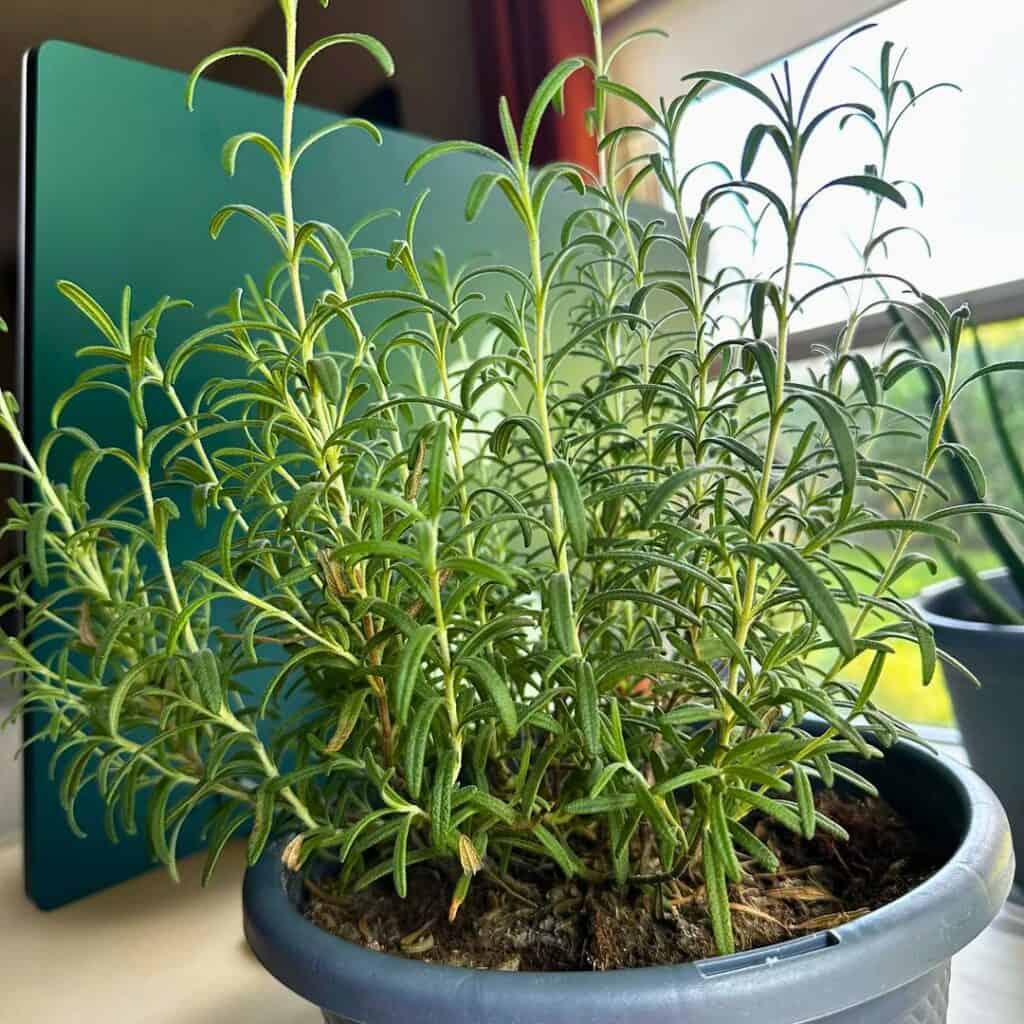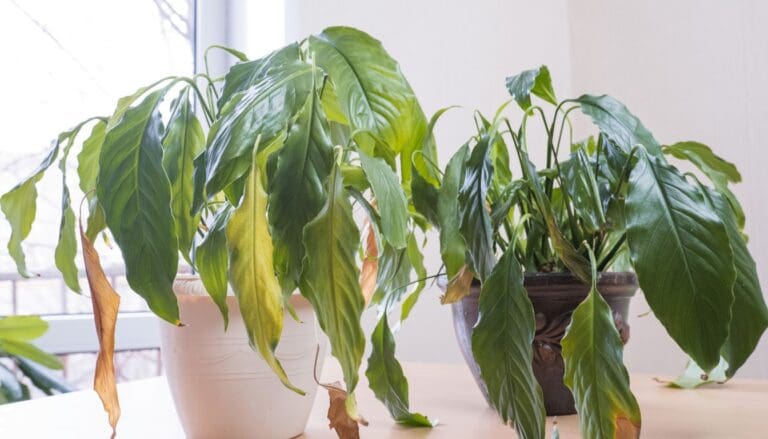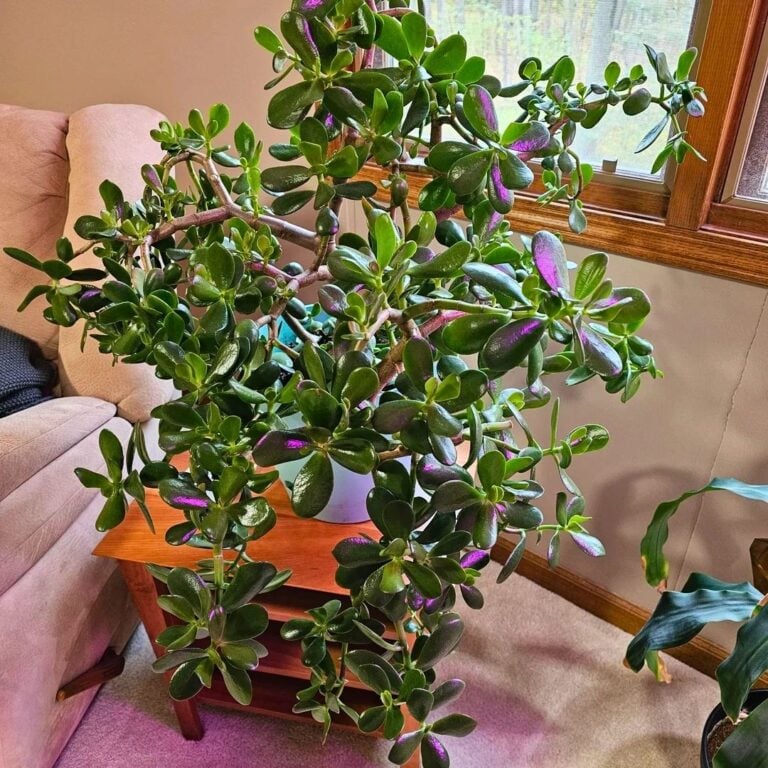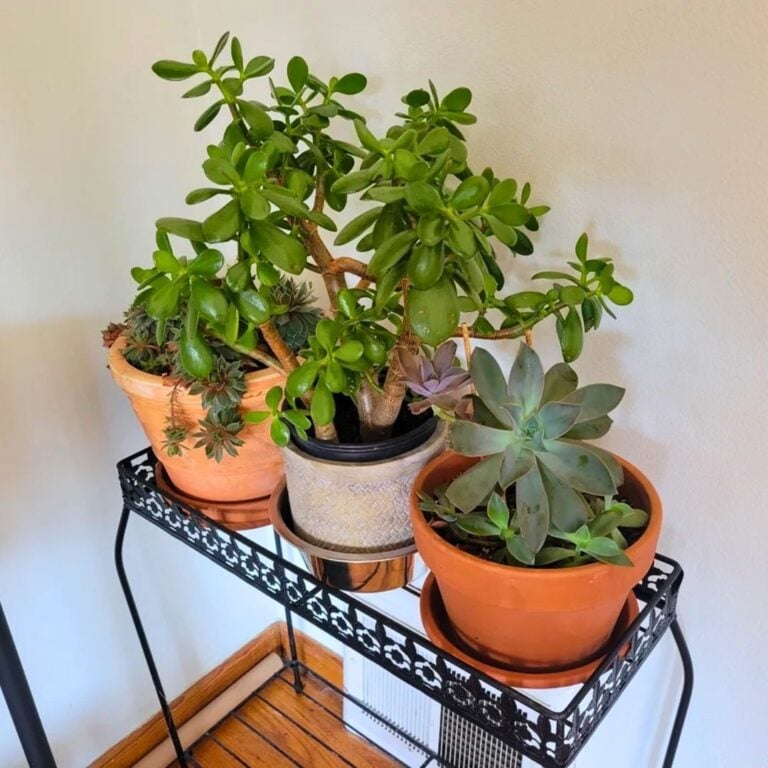11 Tips For Growing Rosemary In Pots Like A Pro
I’ve always loved growing herbs, but rosemary just hits different. It’s beautiful, smells incredible, and honestly, it just makes food taste way better.
Figuring out how to grow rosemary in pots means I get to have it around all year, even if my garden space is tiny.
When I first tried, I had no idea how much the little things mattered.
Picking the right pot, getting the light just right, not drowning the poor thing—each step really adds up.
So here’s what I’ve learned about making rosemary in pots easy and, well, actually enjoyable.
Please note: Simplify Plants is reader-supported. As an Amazon Associate, I earn from qualifying purchases made by our readers with no extra cost added to you all! Some links in the post are affiliate links and I get a commission from purchases made through links in the post.
1) Choose a pot with drainage holes

I always start with a pot that has drainage holes at the bottom. Rosemary absolutely hates soggy feet—those holes let the extra water out.
For material, I usually go for clay or terracotta. They let the soil breathe a bit. Plastic works, but it tends to hold too much moisture, which makes things tricky.
The pot doesn’t need to be massive, but at least 12 inches wide gives the roots some space. Too small, and the soil dries out in a flash.
I always use a saucer or tray underneath to catch the drainage. Keeps my windowsill or patio tidy and the plant happy.
Whenever I repot, I double-check those holes aren’t blocked. Good drainage is the secret to healthy rosemary roots, no doubt about it.
2) Use well-draining cactus or succulent soil

I stick with well-draining cactus or succulent soil for rosemary. It keeps the roots from sitting in water and getting mushy. This herb likes things on the dry side, so drainage is non-negotiable.
I avoid heavy garden soil—it just holds too much moisture. Instead, I look for a mix with sand or perlite. Airy and loose is the goal.
If I can’t find cactus soil, I just mix my own: two parts potting soil, one part coarse sand, one part perlite. It ends up dry and crumbly, exactly what rosemary likes.
Even with the right soil, I make sure the pot has drainage holes. No point in perfect soil if the water can’t escape.
Using the right soil really does make rosemary easier to care for. I notice the leaves stay firmer and the plant just looks happier.
3) Place rosemary in a sunny spot with at least 6 hours of light
Rosemary craves sunlight—at least 6 hours a day, minimum. If it doesn’t get enough, it just gets spindly and sad.
Inside, I keep it near a south-facing window. That’s where the light is best. If it still seems a bit gloomy, I’ll add a grow light. It’s a bit extra, but worth it.
Outdoors, I find the sunniest spot I can. I avoid shady corners or spots where rainwater pools. Dry, warm leaves are best.
When rosemary gets enough sun, the flavor and scent are way stronger. If the leaves start looking pale, I know it needs more light.
Even in winter, I try to keep the light levels up. I’ll rotate the pot every few days so it doesn’t lean too much. It’s a small thing but helps a lot.
Honestly, keeping rosemary in a bright, sunny spot makes all the difference. It’s one of those plants that really rewards you for paying attention.
4) Water only when the top inch of soil is dry

I don’t water on a schedule—I just stick my finger in the soil. If the top inch feels dry, that’s my cue. If it’s damp, I give it another day or two.
Rosemary hates wet feet. Too much water and you’re in root rot territory. I always use pots with drainage holes to let the extra water out.
When it’s time, I water deeply until it runs out the bottom, then stop. That encourages deep roots and a sturdier plant.
I’ve noticed it needs less water in cool weather, more when it’s hot and dry. So I adjust based on the season, not the calendar.
If I’m not sure, I’ll use a moisture meter or just poke around in the dirt. It’s honestly better to underwater than overwater—rosemary can handle a bit of dryness.
With this routine, my rosemary stays green and perky. Careful watering really is a game-changer.
5) Avoid overwatering to prevent root rot
I’ve learned the hard way: rosemary likes to dry out between waterings. Too much water and the roots suffocate, plain and simple.
I always check the soil before adding more water. If it’s dry on top, I’ll water. If not, I wait.
Those drainage holes in the pot are non-negotiable. I also dump out any water that collects in the saucer below.
Less is more with rosemary. I’d rather let it dry out a little than risk soggy soil.
When I water, I do it thoroughly, then wait until the soil dries out again. That’s what keeps the roots healthy and strong.
In cooler months, I cut back even more. The plant just doesn’t need as much.
6) Fertilize monthly with a balanced liquid fertilizer

I give my rosemary a balanced liquid fertilizer about once a month. Nothing fancy—just a basic 10-10-10 formula.
I always dilute it to half strength. Too much fertilizer can actually dull the flavor, which is kind of the whole point of growing rosemary, right?
I pour the fertilizer into the soil after watering, never on the leaves. That way, the roots get what they need and I don’t risk leaf burn.
During winter, I cut back on feeding. Growth slows down, so it’s just not necessary.
If the leaves look pale or growth stalls, I’ll check if I missed a feeding or if something else is off. Usually, a quick fix gets things going again.
Simple, steady feeding keeps my rosemary strong and ready for harvest whenever I need it.
7) Prune regularly to encourage bushy growth
I’ve found that pruning often is the secret to a bushy, happy rosemary plant. Trimming it back helps it grow more side branches instead of just shooting up.
Once it hits about six inches tall, I start snipping. I use clean scissors and cut just above a leaf node—that’s where new growth pops out.
I never take off more than a third at once. Too much at once stresses the plant out. Little and often works best.
After trimming, I clear away any dead or woody stems. That keeps the air moving and helps prevent mildew or pests.
I like to prune in the morning, when it’s still cool. The plant seems to bounce back faster.
Pinching off the soft tips every few weeks keeps the shape neat and rounded. If I skip pruning, the plant gets leggy, but it usually recovers once I get back to trimming.
Consistent pruning keeps rosemary lush and smelling amazing.
8) Rotate the pot weekly for even sunlight exposure

I try to rotate my rosemary pot once a week so all sides get a fair share of sunlight. Otherwise, it starts leaning toward the window and looks a bit lopsided.
If I forget, the stems stretch out toward the light and the shaded side gets a bit sparse. A quick turn keeps things balanced.
Usually, I just rotate it when I water. That way, I don’t forget. No need to be precise—just keep it moving.
Near a window, I rotate more often since the light comes from one direction. Outdoors, I still turn it weekly because the sun’s angle changes.
I’ve noticed rotating helps the stems stay sturdy. Even sunlight makes for a much healthier, better-looking rosemary plant.
9) Protect rosemary from frost during winter
When winter rolls around, I always try to shield my rosemary from frost. Cold snaps can really mess up the leaves and roots, especially if temps dip below freezing.
I usually move my pots indoors or tuck them into a sheltered spot—a sunny windowsill or even an enclosed porch works. Rosemary absolutely loves sunlight, so I make sure it gets at least 6 hours of light a day.
If dragging the pot inside isn’t an option, I wrap it with burlap or frost cloth to help trap a bit of warmth. I also toss some mulch or straw over the soil to give the roots a little extra protection.
During winter, I’m careful not to overwater. Cold, soggy soil can lead to root rot, so I let the top inch dry out before watering again.
On those rare warmer days, I’ll crack a window or set the pot outside for a few hours. The fresh air perks the plant up and helps keep mildew away.
If there’s frost in the forecast, I cover the rosemary with a lightweight sheet or plastic dome before sunset. In the morning, I take the cover off so it can breathe and soak up some sun.
I just try to keep an eye on the weather and make little adjustments. It’s not foolproof, but it helps my rosemary stay green and healthy through winter.
10) Use a pot at least 12 inches deep

I always go for a pot that’s at least 12 inches deep when I’m planting rosemary. It gives the roots more room to stretch and makes for a sturdier, happier plant.
Shallow pots just dry out too fast and the plant struggles. A deeper pot holds moisture longer, which rosemary appreciates—even though it doesn’t like soggy soil.
I never forget to check for drainage holes at the bottom. Without them, water just sits there and you end up with root rot. A deep pot with good drainage really keeps things on track.
When I repot, I peek at the roots. If they’re circling the bottom, it’s time for a bigger home. Giving roots more space always seems to help rosemary live longer and look better.
I’ve also noticed deeper pots keep the plant steady—handy if you’re growing rosemary outside and the wind picks up. A sturdy, deep pot supports upright growth and keeps everything from tipping over.
Honestly, picking the right pot size sounds simple, but it really does make a huge difference. I stick with at least 12 inches deep and my rosemary has never complained.
11) Add mulch to retain moisture
I’m a fan of adding mulch to my rosemary pots. It helps the soil stay moist, especially when the sun and wind are working against you.
I like using organic mulch—shredded bark, straw, or even small wood chips. They look nice and break down slowly. Heavy mulches can trap too much water, so I steer clear of those.
When I spread mulch, I leave a little gap around the base of the plant. That way, the stem stays dry and I avoid rot. About an inch of mulch does the trick without smothering the soil.
Mulch also keeps the soil temperature more stable. It’s like a little blanket—roots stay cooler on hot days and warmer when it’s chilly.
Every few weeks, I check the mulch. If it’s looking thin or has blown away, I just top it up. Keeping it fresh means less watering for me and a happier plant.
It might sound basic, but mulch is one of the best ways I’ve found to save water and keep rosemary thriving.
Understanding Rosemary’s Needs
I’ve figured out that rosemary needs a good mix of well-draining soil, strong sunlight, and just the right amount of water. All these things really shape how healthy and tasty the plant gets.
Ideal Soil and Drainage
I always start with light, sandy soil that drains quickly. Rosemary just hates sitting in water—heavy or clay soil is a no-go for me.
My mix is usually two parts potting soil, one part coarse sand, and one part perlite. That keeps the roots from getting waterlogged.
Good drainage is everything. I pick a pot with drainage holes and sometimes toss a few small stones at the bottom for airflow.
If the soil feels dry on top before watering again, I know I’m on the right track. If it stays wet too long, I add more sand or perlite. Loose, airy soil is just better for rosemary.
Sunlight Requirements
Rosemary is a sun lover. I make sure it gets at least 6 to 8 hours of direct light every day.
If I’m growing it inside, I park it near a south-facing window or pop on a grow light when the sunlight isn’t cutting it. Rotating the pot every few days helps all sides get some love.
If it’s scorching outside, I’ll move the pot to catch morning sun and afternoon shade. That way, it gets enough light without drying out too fast.
Watering Best Practices
I water rosemary deeply but not too often. Letting the top inch of soil dry out before watering again is my rule of thumb.
In summer, I usually water once or twice a week, depending on how hot and dry things get. When it cools down, I might stretch it to every 10–14 days.
I pour water slowly until it trickles out the bottom—roots get what they need, but nothing stays soggy. A watering can with a narrow spout helps me keep things tidy.
If the leaf tips turn brown, I know I’ve either overdone it or waited too long. Adjusting the schedule usually brings things back.
Common Challenges When Growing Rosemary in Pots
I’ve run into a few headaches keeping rosemary happy in pots. The big ones? Too much water and pests that chew up the leaves or roots.
Spotting these problems early makes all the difference—otherwise, rosemary just goes downhill fast.
Preventing Root Rot
Root rot is a pain and usually shows up if the soil stays wet for too long. I always use pots with drainage holes and a well-draining mix—coarse sand, perlite, and potting soil are my go-tos.
I stick to watering only when the top inch of soil feels dry. Overwatering is worse than underwatering for rosemary, honestly.
If I spot yellow leaves or catch a musty smell, I check the roots. Healthy ones are white and firm; rotten roots are brown and mushy.
If there’s rot, I snip off the bad parts and repot in fresh, dry soil. I’ll even wash the pot with mild soap to get rid of any lingering fungus. A sunny, breezy spot helps keep the problem from coming back.
Managing Pests and Diseases
Pests like aphids, spider mites, and whiteflies love rosemary as much as I do. I check the leaves often, especially underneath, since bugs hide there.
If I spot tiny webs or sticky stuff, I know pests have moved in. I spray the leaves with water or insecticidal soap, or wipe them gently with a damp cloth if it’s not too bad.
I skip harsh chemicals—they usually do more harm than good and seem to attract more trouble later.
Sometimes fungal diseases pop up if the air’s too still. I trim crowded stems and avoid getting the leaves wet when watering. Bright light and good airflow keep things healthy.
Frequently Asked Questions
Healthy potted rosemary really comes down to the right container, soil, sunlight, and watering habits. Keeping pests at bay and protecting the plant through cold weather helps a lot, too.
What type of pot is best for planting rosemary?
I always pick a pot with drainage holes. Terra-cotta or clay pots are my favorites—they let air reach the roots and help the soil dry out faster.
How often should I water potted rosemary plants?
I only water when the top inch of soil feels dry. Overwatering is a quick way to get root rot, so I let the soil dry out between waterings.
Do I need to fertilize my rosemary, and if so, what should I use?
I feed my rosemary once a month in spring and summer with a balanced liquid fertilizer (diluted to half strength). Too much fertilizer just makes the flavor weaker.
How much sunlight does a rosemary plant need to thrive in a container?
My rosemary does best with at least 6 hours of direct sunlight daily. I keep it near a sunny window or out on the patio where it gets plenty of light.
Can rosemary survive winter in a pot, and how can I protect it?
If it’s cold, I move the pot indoors near a sunny window or stash it in a cool, bright spot. When frost threatens, I cover the plant or bring it inside—anything to keep it from freezing.
What are the common pests to look out for when growing rosemary indoors?
I usually keep an eye out for aphids, spider mites, and whiteflies. These little guys show up more often than you’d expect.
If I spot any, I’ll give the leaves a good rinse with water. Sometimes, I’ll reach for a gentle insecticidal soap—it’s honestly a lifesaver for keeping things under control.
Recommended Garden Supplies
| Product Image | Our Recommended Gardening Supplies | Check Offers! |
|---|---|---|
Top Top
Top
Top
Top
Top
Top
Top
Top | rePotme Houseplant and Tropical Classic Potting Soil Mix | Check Offer On Amazon |
 Top
Top
Top
Top
Top
Top
Top
Top | Espoma Organic Indoor Plant Food | Check Offer On Amazon |
 Top
Top
Top
Top
Top
Top
Top
Top | GooingTop LED Grow Light 6000K Full Spectrum Clip Plant Growing Lamp | Check Offer On Amazon |
 Top
Top
Top
Top
Top
Top
Top
Top | Soil Moisture Meter | Check Offer On Amazon |
 Top
Top
Top
Top
Top
Top
Top
Top | Govee Hygrometer Thermometer, Bluetooth Enabled! | Check Offer On Amazon |
 Top
Top | LEVOIT Humidifiers for Large Room(Best For Plants) | Check Offer On Amazon |
 Top
Top
Top
Top
Top
Top
Top
Top | Upgraded DIY Automatic Drip Irrigation Kit, 15 Potted Houseplants Support | Check Offer On Amazon |
 Top
Top
Top
Top
Top
Top
Top
Top | Stainless Steel Heavy Duty Gardening Tool Set | Check Offer On Amazon |
 Top
Top
Top
Top
Top
Top
Top
Top | Bonide Insecticidal Soap | Check Offer On Amazon |
 Top
Top
Top
Top
Top
Top
Top
Top | Bonide 32 oz Spray Neem Oil for Organic Gardening | Check Offer On Amazon |
 Top
Top
Top
Top
Top
Top
Top
Top | Garden Safe Fungicide | Check Offer On Amazon |






